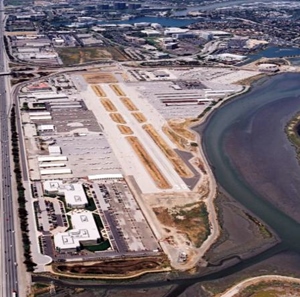 Pilots at a California airport that flunked an Environmental Protection Agency lead air-quality test are crying foul. The EPA recently released results of a study of airborne lead at 17 airports around the country where monitors were placed to measure air quality in public areas. While nearly all passed the test, San Carlos Airport south of San Francisco had unusually high readings – and now we may know why.
Pilots at a California airport that flunked an Environmental Protection Agency lead air-quality test are crying foul. The EPA recently released results of a study of airborne lead at 17 airports around the country where monitors were placed to measure air quality in public areas. While nearly all passed the test, San Carlos Airport south of San Francisco had unusually high readings – and now we may know why.
The EPA’s lead monitor at San Carlos was placed near the aircraft runup area at the threshold of Runway 30, directly in the prop blast of airplanes waiting to depart in apparent violation of the agency’s own test guidance. The three-month average airborne lead readings at the airport were more than double the EPA’s allowable threshold. But the agency’s study, launched in 2010, called for positioning the monitors in areas of undisturbed “ambient” air in places accessible to the public – which appears not to have been the case at San Carlos.
“Well before the results of the tests were released, we communicated to the EPA what we viewed as non-compliance with the agency’s own test standards,” said Michael Baum, a board member of the San Carlos Airport Association. The EPA, he said, originally planned to place the airport’s lead monitor adjacent to a parking lot farther away from the runup area. For reasons that are still unclear, he said, the agency changed the location to an area that is inaccessible to public and within the airport’s protected area.
“Effectively,” he said, “the only thing they were monitoring was the air coming right out of the tailpipes of airplanes doing their runups.”
The airport has since temporarily moved the runup area farther away from the parking lot, which sits behind a chain-link fence with plastic slats. The airport association contends that had readings been taken on the opposite side of the fence, they likely would have been much lower than those recorded near the runup area. Only one other airport besides San Carlos – McClellan-Palomar Airport in San Diego County – recorded lead levels that exceeded federal standards.
“We were told by an independent environmental scientist that if the monitor was moved to the publicly accessible area on the other side of the fence, lead levels would have dropped by 80 percent,” said Carol Ford, the airport association’s president. She said repeated requests asking the EPA to explain why it chose to place the monitor where it did have gone unanswered.
For now, pilots at San Carlos will continue to query the EPA about its testing methodology.
“I understand what the EPA was trying to do, but good science should control what’s happening here,” Baum said. “If not, then isn’t all of this a charade?”
Read more at http://www.flyingmag.com/news/airport-disputes-epa-lead-air-study-findings#kSx1i2Vah0UmbWAG.99
